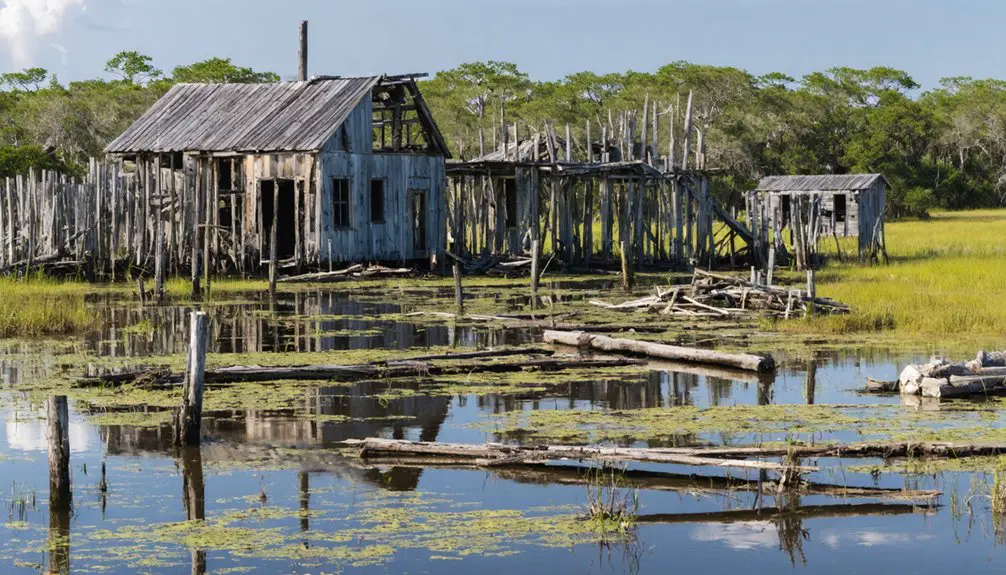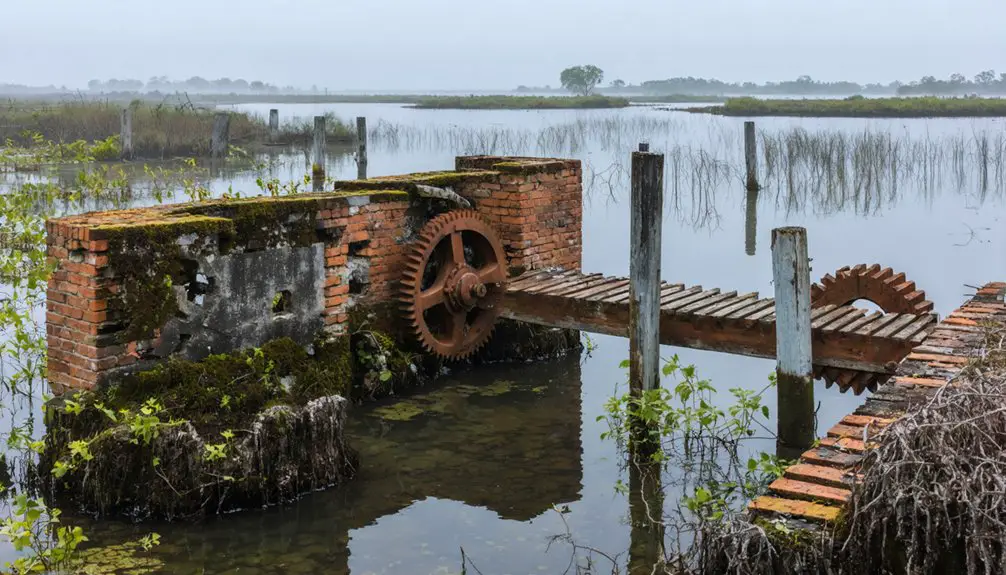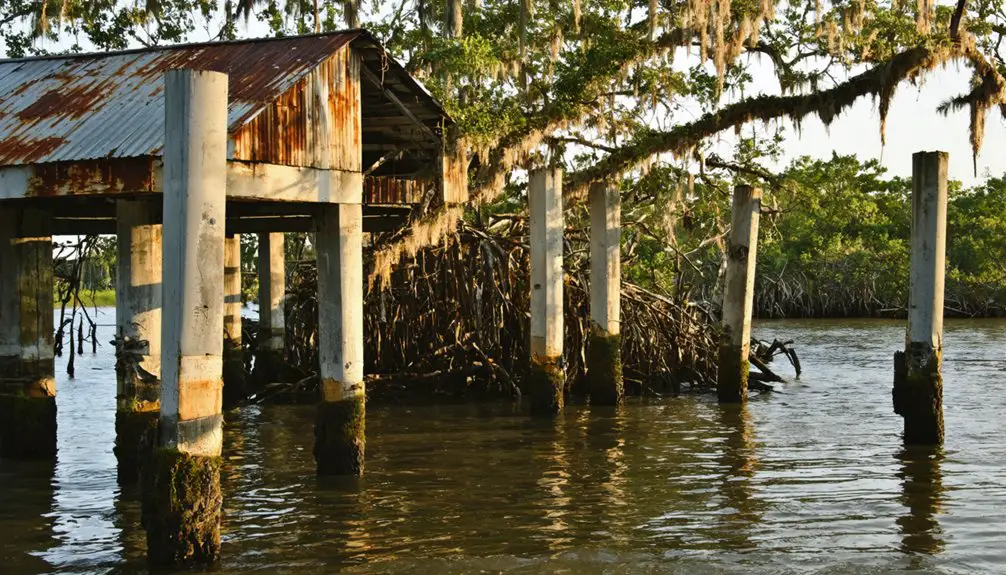You’ll find Ritta Island, an abandoned ghost town, five miles east of Clewiston on Lake Okeechobee’s southern shore. This former agricultural settlement thrived from 1909 until the catastrophic Hurricane of 1928 forced its permanent abandonment. The community endured earlier challenges, including the Great Flood of 1922, but couldn’t survive the Category 5 hurricane that claimed over 3,000 lives. Today, nature has reclaimed the island, but traces of this frontier settlement’s dramatic story remain beneath the surface.
Key Takeaways
- Ritta Island was an agricultural settlement established in 1909 on Lake Okeechobee’s southern shore before becoming a ghost town in 1928.
- The island community thrived on farming and fishing until devastating floods in 1922 began driving residents away.
- A Category 5 hurricane in 1928 caused catastrophic flooding, destroying infrastructure and claiming over 3,000 lives around Lake Okeechobee.
- After the 1928 hurricane, residents permanently abandoned Ritta Island, leaving it to be reclaimed by native vegetation and marsh habitat.
- Today, Ritta Island is only accessible by boat and contains buried building foundations from the original settlement near Clewiston.
The Lost Settlement of Lake Okeechobee
While many ghost towns across America succumbed to economic decline, Ritta Island‘s fate was sealed by nature itself. Located on Lake Okeechobee’s southern shore, this ambitious settlement faced extraordinary environmental challenges from its inception in 1909.
Nature, not economics, doomed Ritta Island – a bold Lake Okeechobee settlement that battled environmental forces from day one.
You’ll find its coordinates at 26°43′18″N 80°48′18″W, where early pioneers like John Windham and Mays Thomas confronted the formidable task of clearing dense custard apple trees to establish farmland. This remote location in Palm Beach County made access and supplies difficult for settlers. A reliable connection to the mainland was maintained by Captain Ed Forbes, who operated the mail boat service to the island’s post office.
The settlement challenges proved relentless. With only one mule for plowing and persistent flooding threats, settlers struggled to maintain their corn, onion, and green bean crops.
The environmental impacts were devastating – the 1922 floods submerged the island under a foot of water, bringing water moccasins and destroying harvests.
Early Pioneers and First Inhabitants
The story of Ritta Island’s pioneers began in 1909 when the first settlers ventured onto this remote Lake Okeechobee outpost.
You’ll find that these early homesteaders faced immediate pioneer challenges, having to clear dense custard apple forests before they could even begin farming their land. The settlers engaged in a constant struggle against nature as they worked to maintain their foothold on the island.
After the U.S. Government’s 1917 survey opened official settlement, notable pioneers like John Windham, Mays Thomas, and Captain Ed Forbes established themselves on the island.
The settlement dynamics revolved around subsistence agriculture, with settlers growing corn, onions, and green beans using just one mule for plowing.
Captain Forbes managed the essential mail boat service that connected the island’s post office to the mainland, providing a significant lifeline for these determined pioneers who carved out their independence in Florida’s wilderness. Like many early Florida settlements, their community would face numerous challenges as they worked to establish permanent roots in the region.
Life on a Lakeside Paradise
You’d find daily life on Ritta Island centered around agricultural pursuits, with farmers tending to vegetables, sugarcane, and fruit trees in the rich custard apple muck soil.
Living near Lake Okeechobee‘s waters meant you’d spend your days monitoring water levels and maintaining drainage systems essential for crop success. Early families relied on hand tools to cultivate their land, working together to clear and maintain their farms.
You’d supplement your farming income through fishing the lake’s abundant waters, while building community connections around the Mabry post office and shared facilities. With Lake Okeechobee’s 730 square miles of water surrounding the island, residents had ample fishing opportunities at their doorstep.
Daily Island Routines
Living on Ritta Island demanded a structured daily rhythm that began with sunrise activities and stretched well into the evening hours.
You’d start your mornings clearing land and tending to essential household tasks, often joining neighbors for communal chores like removing custard apple trees. The lake dictated your fishing techniques, with small boats heading out during prime morning and evening hours.
Your daily responsibilities included maintaining boats, preserving crops, and mending essential tools. You’d coordinate with Captain Ed Forbes’ boat service for mail exchanges, connecting you to mainland news.
After sunset, you’d gather with fellow islanders to share stories and plan tomorrow’s work. Weather awareness shaped every decision, from choosing when to fish to protecting your homestead from floods and tropical storms.
Farming Near Lake Waters
While Lake Okeechobee‘s waters lapped at Ritta Island’s shores, pioneering farmers transformed the fertile Torry muck soil into an agricultural paradise starting in 1904.
You’d find a diverse range of crops thriving in the rich soil – from vegetables and sugar cane to tropical fruits like bananas and coconuts.
Despite limited tools and basic irrigation techniques, you could work the land year-round in the mild climate.
Your crop rotation might include corn, beans, and tomatoes in carefully managed fields carved from cleared pond apple forests.
But you’d face constant challenges – your harvests had to survive a complex journey to market via Lake Worth and Jupiter, often taking weeks to reach destinations like Jacksonville.
The surrounding waters that made farming possible could also destroy everything when floods and hurricanes struck.
The Lake Worth Drainage District established in 1915 helped farmers by managing water levels and reclaiming land for cultivation.
Agricultural Legacy and Daily Living
You’d find farming on Ritta Island to be a labor-intensive endeavor, with a single mule for plowing and limited mechanization shaping the daily agricultural routine.
Your crop selection would include vegetables like tomatoes and peppers, along with sugar cane and tropical fruits that thrived in the rich muck soil. The fertile land sat in a shallow geological trough that had transformed from dry ground to wetlands thousands of years ago.
Getting your harvested produce to market meant relying on Captain Ed Forbes’ mail boat service until the Florida East Coast Railroad provided faster transport options for perishable goods.
Farming Methods and Tools
Early farmers on Ritta Island faced unique agricultural challenges that shaped their farming methods between 1904 and 1909. You’d find them clearing dense pond apple trees and Okeechobee gourd vines by hand to access the fertile muck soil beneath.
Their farming techniques relied heavily on a single mule for plowing, as mechanized equipment couldn’t navigate the swampy terrain. Like the lost town Ameron, they specialized in growing tomatoes, strawberries and other produce suited to the soil conditions.
To succeed in these challenging conditions, they’d implement crop rotation with diverse plantings including corn, onions, pineapples, and citrus.
You’d see them maintaining drainage canals to protect their fields from flooding while harvesting crops manually for northern markets.
The farmers adapted through local knowledge and experimentation, learning to work with the tropical climate and rich soil despite the constant threat of floods and limited infrastructure.
Daily Transportation Challenges
Life on Ritta Island revolved around three core transportation challenges that shaped daily existence between 1904 and 1928.
You’d face daily mobility issues due to limited 2WD roads and no docks, forcing reliance on boats for essential connections to the mainland. Weather impact constantly threatened your movement – floods made paths hazardous and increased water moccasin presence, while storms disrupted critical mail delivery and supply runs. The elevated rail lines helped minimize flooding issues in other regions during this era.
Agricultural transport proved especially demanding without mechanized equipment.
You’d depend on mules for farming and simple wagons to move crops, while Captain Ed Forbes’s mail boat service provided your lifeline for supplies and communication.
These transportation limitations, combined with the island’s isolation in Lake Okeechobee, meant you’d struggle daily with access issues until the devastating 1928 hurricane destroyed what little infrastructure existed.
Crop Types and Seasons
Several pioneering crops flourished in Ritta Island‘s fertile muck soils between 1904 and 1928, transforming the former wetland into productive farmland.
You’d find impressive crop diversity, from vegetables like peas, beans, radishes, and tomatoes to tropical fruits including bananas, grapefruits, and avocados. Sugar cane became a significant crop, while pineapples and pumpkins added to the agricultural variety.
The seasonal cycles governed planting and harvesting times, with vegetable crops following natural ripening patterns. Fruit trees required longer growing periods, often spanning multiple months.
Once harvested, you’d need to pack your crops quickly for northern markets, though transportation could take weeks. The region’s subtropical climate and careful drainage management proved essential for maintaining this agricultural abundance in the rich Torry muck soil.
The Great Flood of 1922
Heavy rains pummeled Ritta Island in 1922, triggering catastrophic flooding that marked the beginning of the settlement’s decline. The floodwaters overwhelmed both natural and man-made containment systems, while the Kissimmee River‘s rising levels further intensified the disaster.
You’ll find that flood resilience was nearly impossible as water lingered for weeks, destroying homes, crops, and critical infrastructure.
The flooding’s impact hit non-white agricultural workers particularly hard, forcing many families to abandon their homesteads. Community rebuilding efforts faced significant challenges as standing water blocked key roadways, hampering relief attempts.
Marginalized farming families bore the heaviest burden, losing both homes and livelihoods as floodwaters cut off escape routes.
The disaster sparked a pattern of water-related calamities around Lake Okeechobee, leaving the region increasingly vulnerable to future catastrophes. This devastating flood ultimately exposed the urgent need for improved water management systems in the area.
The Devastating Hurricane of 1928

A catastrophic Category 5 hurricane slammed into Florida’s coast in September 1928, releasing devastating 150 mph winds and a 10-foot storm surge that would forever alter Ritta Island’s fate.
Historical records show the storm’s impact triggered Lake Okeechobee to breach its inadequate dikes, unleashing a deadly wall of water.
The flooding devastation around the lake was unprecedented, with emergency response severely hampered by destroyed infrastructure.
You’ll find these stark statistics about the hurricane’s fury:
- Waters rose 7 feet above ground level
- Over 3,000 deaths occurred in lake communities
- 15,000 families lost their homes
- Property damage reached $25 million ($458 million today)
Despite this overwhelming destruction, community resilience prevailed as survivors rebuilt, leading to the construction of the Herbert Hoover Dike.
Abandonment and Aftermath
Following the destructive 1928 hurricane, you’ll find that Ritta Island was left completely uninhabitable, with nearly all buildings and infrastructure washed away.
The last remaining residents permanently abandoned the settlement, leaving behind their agricultural pursuits and homesteads that had been established since 1909.
Today, the island stands as an isolated ghost town, largely inaccessible and reclaimed by nature, with minimal physical evidence of its former community remaining.
Natural Forces Take Over
When devastating rains struck Ritta Island in 1922, they triggered a chain of natural events that would ultimately seal the settlement’s fate. The flood’s destructive power submerged the island under a foot of water, destroying crops and initiating a natural restoration process that would transform the landscape.
You’ll find nature quickly reclaimed the island through:
- Water moccasins establishing dominance, altering local wildlife dynamics
- Native custard apple trees returning to their original territory
- Vegetation overtaking abandoned farmland and deteriorating structures
- Wildlife populations flourishing without human interference
The 1928 hurricane delivered the final blow, washing away remaining buildings and infrastructure.
Today, you won’t find many traces of human settlement as ecological balance has been restored, with the island returning to its natural, undisturbed state.
Last Residents Leave
The prolonged departure of Ritta Island’s residents began after the devastating 1922 floods, which submerged the entire settlement under more than a foot of water.
Despite the community’s resilience, the flood destroyed crops and brought an infestation of water moccasins, making daily life increasingly dangerous and unsustainable.
The evacuation timeline accelerated as farming became impossible and isolation from the mainland intensified due to inadequate docks and transportation.
You’ll find that most residents had already relocated when the catastrophic 1928 hurricane delivered the final blow, destroying all remaining buildings and infrastructure.
This natural disaster marked the permanent end of human habitation on Ritta Island.
Today, you won’t find any visible traces of the original settlement beyond possible building foundations.
Return to Wilderness
Nature swiftly reclaimed Ritta Island after its final abandonment in 1928, transforming farmland back into wilderness through unchecked ecological succession.
Custard apple trees, native to the region, spread across former agricultural fields while flooding reshaped the island’s hydrology and ecosystem.
You’ll find evidence of wilderness recovery in these dramatic changes:
- Heavy rains submerged the island under more than a foot of water
- Water moccasins and wildlife populations surged as humans departed
- Native vegetation overtook all cleared areas
- Buildings and infrastructure crumbled into barely visible remnants
Today, you can only access this wild paradise by private boat, where you’ll discover a largely untouched landscape.
The island stands as a symbol of nature’s resilience, with just faint traces of human civilization visible through aerial surveys.
Natural Reclamation and Modern State
Following its abandonment in 1922, devastating floods submerged Ritta Island under more than a foot of water, marking the beginning of nature’s gradual reclamation process.
You’ll find no trace of the once-bustling settlement today, as the 1928 hurricane washed away most buildings, accelerating ecological succession. Water moccasins quickly invaded the flooded terrain, signaling wildlife’s return.
The island you’d discover now exists in almost total isolation, accessible only by boat. Native vegetation, including custard apple trees, has reclaimed cleared areas.
Without human interference, the land has transformed into a natural refuge where marsh habitat thrives. While building foundations might remain buried somewhere on the island, nature’s dominion has largely erased these marks from cultural memory.
Historical Significance in Florida’s Development

As Florida’s agricultural frontier expanded in the early 1900s, Ritta Island emerged as a microcosm of the state’s broader homesteading movement.
You’ll find its cultural influences reflected in the determined spirit of settlers like John Windham and Captain Ed Forbes, who carved out a living through subsistence farming and community cooperation.
The island’s community dynamics showcase key elements of frontier life:
- Self-sufficient agricultural practices focused on corn, onions, and green beans
- Integration into regional networks through mail boat service
- Adaptation to subtropical climate conditions
- Resilience against environmental challenges until 1928
You’re witnessing, through Ritta Island’s story, how Florida’s early development hinged on small farming communities that tested the limits of agricultural possibility in challenging environments.
Florida’s frontier story lives through places like Ritta Island, where determined farmers pushed the boundaries of what the land could yield.
Its eventual abandonment serves as a powerful reminder of nature’s impact on settlement patterns.
Exploring a Forgotten Community
Today, when you venture five miles east of Clewiston across Lake Okeechobee’s southern edge, you’ll find the remnants of Ritta Island’s forgotten settlement, where homesteaders first carved out their existence in 1909.
Early settlement patterns reveal a hardy community that cleared dense custard apple trees to establish farms, growing corn, onions, and green beans with just a single mule for plowing.
Environmental impacts proved devastating for these pioneers. The 1922 flood submerged the island under a foot of water, bringing dangerous water moccasins and destroying crops. Most residents fled, and those who remained faced complete destruction in the catastrophic 1928 hurricane.
Today, you won’t find docks or roads to access this ghost town – just an uninhabited island where nature has reclaimed what was once a hopeful frontier community.
Frequently Asked Questions
Are There Any Underwater Archaeological Remains Visible During Low Water Levels?
While you’d expect everything to be hidden, you’ll find fascinating underwater archaeological findings during low water, including Native American artifacts and settlement remains through careful underwater exploration of exposed lakebeds.
What Wildlife Species Have Reclaimed Ritta Island Since Its Abandonment?
You’ll find wood storks, crested caracaras, and snail kites reclaiming the area, while Florida panthers and manatees showcase the ecological impact. Native species like the Okeechobee gourd are also returning.
Did Any Original Ritta Island Residents’ Descendants Settle in Nearby Communities?
You’ll find descendant stories suggest many families moved to Clewiston, Belle Glade, and Canal Point, maintaining community ties through agricultural work and shared experiences following the 1920s natural disasters.
Were There Any Documented Native American Settlements on Ritta Island?
While Native history surrounds Lake Okeechobee’s shores, you won’t find documented settlement evidence of indigenous communities on Ritta Island itself, despite the region’s rich Native American presence throughout Florida’s past.
Can Visitors Legally Access Ritta Island Today by Boat?
You’ll find unclear access regulations for this location. While there aren’t specific boat permits required, you should verify property ownership and local waterway rules before attempting any landing.
References
- https://en.wikipedia.org/wiki/Ritta_Island
- https://www.ghosttowns.com/states/fl/rittaisland.html
- https://freepages.history.rootsweb.com/~gtusa/usa/fl.htm
- https://www.journaloffloridastudies.org/0102ghosttowns.html
- http://www.gribblenation.org/2018/08/ghost-town-tuesday-ghost-towns-of-lake.html
- https://education.pbchistory.org/pbc_community/three-islands/
- https://evergladeswildernessontheedge.com/wp-content/uploads/2017/05/chap-1.pdf
- https://www.visitflorida.com/travel-ideas/articles/visiting-south-florida/
- https://jacquithurlowlippisch.com/tag/clewiston/
- https://pbchistory.org/a-story-of-agriculture/



